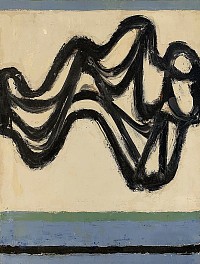BIOGRAPHY

American, 1923-1998
A first-generation action painter, Raymond Hendler started his career as an Abstract Expressionist in Paris as early as 1949. In the years that followed, he played a significant role in the movement, both in New York, where he was the youngest voting member of the New York Artist’s Club. Hendler became a friend of Franz Kline, Willem de Kooning, Jackson Pollock, and Harold Rosenberg in Philadelphia, where he ran an avant-garde gallery between 1952 and 1954.
Hendler differed from Rosenberg’s belief that American post-war painting should have a clear break from the past. His work often recalls the autonomism and nonobjectivism of his European predecessors. However, Stuart Preston noted in The New York Times that Hendler had a “totally different approach to nonobjectivism….He excels in bright hard explicit pattern-making, in straightforward parades of independent shapes, not unlike those in Matisse’s collages. There is something reminding of Leger here as well, particularly in the unambiguous glare of contrasted color and in the robust refusal to allow shapes to suggest anything beyond their merry self."
Raymond Hendler was born in Philadelphia in 1923. In 1949, he continued his art training in Paris at the Académie de la Grande Chaumière on the G.I. Bill. Immersing himself in the Left Bank art scene, he formed close friendships with the Canadian Taschist painter, Jean Paul Riopelle, and the noted Australian sculptor, Robert Klippel. In Paris, he exhibited at the Musée d’Art Moderne and was a founding member of Galerie Huit, the first American cooperative gallery in Europe. Its members included Sam Francis, Al Held, Shirley Jaffe, and Jules Olitski, among others.
Returning to New York in 1951, Hendler became part of the exploding Greenwich Village art scene. He was a voting member of the New York Artist’s Club from 1951 until its end in 1957. He was a friend of the leading figures in the New York School, including the painters Pollock, de Kooning, and Philip Guston and the critic Harold Rosenberg. With Franz Kline, he established a friendship that would last throughout the rest of Kline’s life.
Hendler had frequent solo and group exhibitions in New York, Philadelphia, Minneapolis, and other locations. He was represented by the Rose Fried Gallery during the 1960s and had a series of solo exhibitions until Fried’s death in 1970. In 1963, he received the Longview Foundation Purchase Award, juried by de Kooning, Thomas Hess, Guston, Rosenberg, and David Smith. Since Hendler’s death in 1998, his work has continued to be featured in solo and group shows, many of which are important reconsiderations of the art of the second half of the twentieth century.
Hendler is represented in the collections of numerous museums and public collections in America and abroad, including Birla Academy of Art & Culture, Calcutta, India; Frederick R. Weisman Art Museum, Minneapolis; Grey Art Gallery, New York; J. Walter Thompson Company, New York; Minneapolis College of Art & Design; Minneapolis Institute of Art; New York University; Novartis Co., East Hanover, New Jersey; Philadelphia Museum of Art; Pennsylvania Academy of the Fine Arts, Philadelphia; University of New Mexico, Art Museum, Albuquerque; University of Notre Dame, Indiana; and Walker Art Center, Minneapolis.
